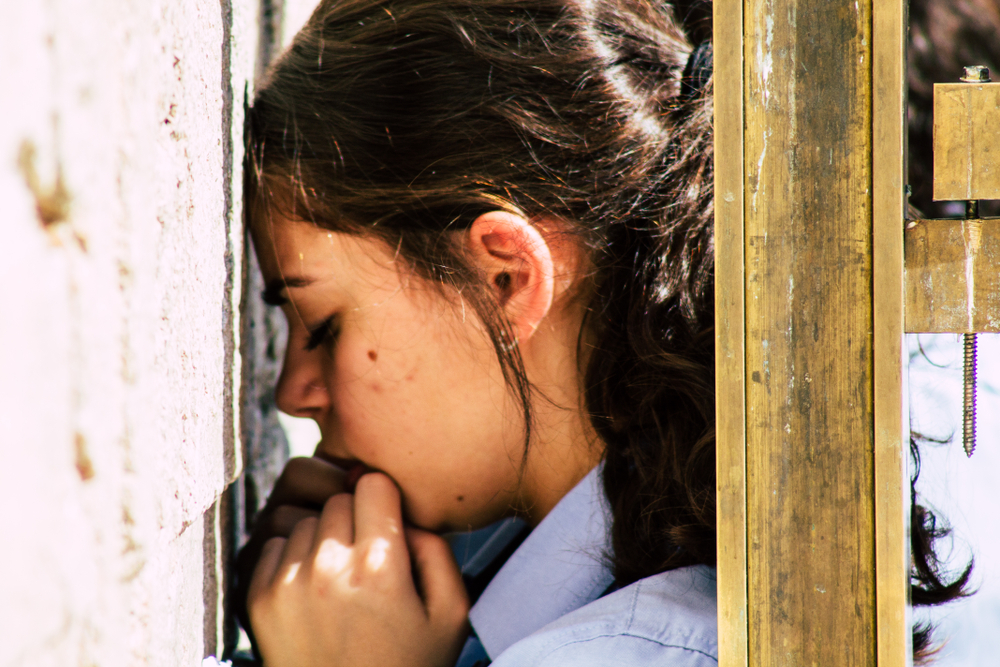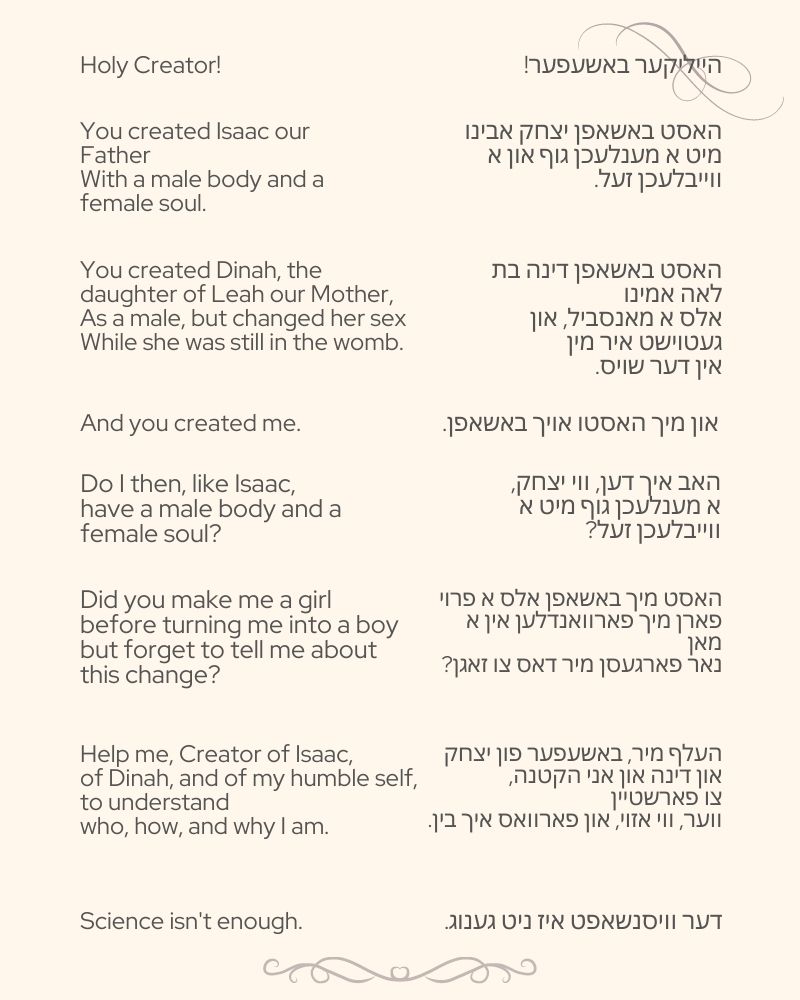
How Can I Be Jewish and Trans? (An Orthodox Transgender Woman Wrestles With God)
Written by Shuli Elisheva
Rabbi Avdimi bar Chama bar Chasa taught in a baraita: “The Holy One, blessed be He, turned Mount Sinai over the heads of the Israelites and said to them, ‘If you accept the Torah, great! But if not, then this is your grave.’” And the Israelites answered: “Na’aseh venishma,” “We will do, and then we will listen.” (Talmud Bavli, Shabbat 88a; Exodus 24:7)
That’s how I felt when I realized I’m transgender.
As I wrote in last month’s issue, I never chose to be transgender. On the contrary, I desperately wanted to not be trans! It flew against everything I had learned about science and Judaism. When I realized I might be trans, I was overcome with terror, confusion, and despair. But after a year and a half of near-daily struggle, I felt as if God were holding a mountain over my head, booming: “If you accept that your Creator has made you a trans woman, great! But if not, then you will die.” And like my ancestors, I finally complied: “I will do, and I will listen.” First I’ll accept, and then I’ll ask more questions.
I am a God-fearing Jew. For as long as I can remember, I’ve lived in mortal terror of performing even the slightest misstep. Why would God make me transgender, if the Torah forbids me from cross-dressing? Why would God make me transgender, if the Torah prohibits me from destroying my beard? How could I, in any conscience, call myself pious while surgically removing the Mark of the Covenant from my flesh?
Now, two years later, I am far more confident with my lot. I have come to understand Judaism as not only permitting but sanctifying, and even commanding, my gender transition. I feel more connected with my Jewish heritage than I ever have before. I have found so many Orthodox transgender friends and role models. With my rabbi’s fullest blessing, I daven on the women’s side at our local modern Orthodox synagogue, lead children’s services on holidays and Shabbat, and use the women’s bathroom. I am even, dare I say it, proud to be living life openly as an Orthodox Jewish transgender woman.
But it was a long road getting here.
On June 4, 2019, I created my first social media
account with a female name: Shuli Elisheva. I wanted to see what it’s like to live openly in the world not only as a woman, but as an Orthodox woman. One of the first things I did was reach out to the only trans person I could think of who has an Orthodox background: Abby Stein. Our stories are extremely different, and she is no longer Orthodox. But she pointed me to Chassidic, kabbalistic, and Talmudic sources that completely blew my mind: a teaching from the 18th century Chassidic master Rabbi Yechiel Michael of Zloczow that Isaac Avinu was born with a male body and a female soul; medieval kabbalistic sources about a man reincarnating in the body of a woman and about the need for all human beings to be simultaneously male and female; a midrash in the Talmud about Dinah bas Leah’s sex being changed from male to female while she was still in the womb; and more. These sources blew my mind, because I had thought that no pre-feminist Jewish writings had anything to say about trans people, let alone affirming the complexity and mutability of Biblical figures’ sex and gender! And yet, there it is, loud and clear, in an 18th century Chassidic text: “It is known, according to the sod [mysticism] of reincarnation, that at times a female would be in a male body, because for reasons of gilgul [the cycling of souls], the soul of a female would come to be in a male.”
At the same time, I began to examine the Biblical prohibitions on cross-dressing and shaving, on my own and with several rabbis. I came to understand that these prohibitions might not be what they seem. The Talmud teaches that the prohibitions on men wearing women’s clothes and shaving their facial/body hair are not inherently about cross-dressing or shaving, but rather about deception for the sake of
maliciously infiltrating vulnerable spaces. Rashi goes a step further, teaching that the ban on cross-dressing only applies for the prevention of adultery. I am not deceiving people when I dress as a woman or laser my hair, nor is my intention to commit adultery or cause harm to any woman. On the contrary, I am a woman! And if I am a woman, is not the Torah commanding me to wear women’s clothing and destroy my beard?
And then, of course, came my yearning for surgery, marred by the troubling spiritual and halachic implications of surgically removing my circumcised flesh. But the more I learned about transgender surgeries, the more I realized that my circumcision will never go away. This coming December, as I lie on the operating table, the skin from my penis and scrotum will be reappropriated to form my new vaginal canal, labia, and clitoris. The Mark of the Covenant will always remain, preserved and protected, under the surface of my female genitalia.
And yet… one overwhelming question remains: WHY did God make me trans? On December 23, 2019, after taking the first dose of pills to feminize my body’s biology, I sat down and wrote a techina, a women’s prayer, in Yiddish and English. In this prayer, I reflected on the teachings about Isaac and Dinah’s transmutable sexes and genders, while imploring my Creator to grant me the deah, binah, and haskel (wisdom, insight, and discernment) “to understand who, how, and why I am… science isn’t enough.”
I’ll conclude this article by sharing the text of my techina, my prayer, in both Yiddish and English, and I look forward to sharing more of my experiences with you in future issues of UNORTHOBOXED.

Related Articles
Related
At the Cross-Section of Neurodiversity and LGBTQIA
Autism, the autism spectrum, and general neurodivergence has been a hot topic for the past three decades. It’s been studied from a medical angle and from a social angle. Information is finally coming together to give society a picture of what it looks like inside the...
Crossing the Mechitza: A Transgender Perspective
One sunny day, 13 years ago, when I was in yeshiva in Jerusalem, I decided to do some grocery shopping. How vividly I remember it, all these years later! One of my friends met me by the door, as I was leaving the yeshiva. He asked if I would pick up some groceries for...
More Than Just Body Parts: The Healing Power of Transgender Surgery
In 1896, Rabbi Yosef Pallache received an unusual shayle (religious question). “Do not be surprised by this question,” the shayle cautions, “since all things are possible, and there is nothing new under the sun.” The question concerns a married woman who spontaneously...
